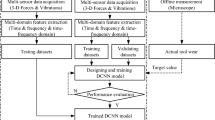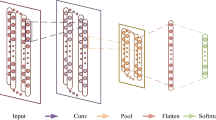Abstract
Bad conditions during machining cause tool chatter, wear, or breakage, which affect the tool life and consequently the surface quality and dimensional accuracy of the machined workpiece. Therefore, for the purposes of production efficiency and economics, monitoring and diagnostics of the tool’s condition are important. This study presents a one-dimensional convolutional neural network (1D-CNN) and deep generalized canonical correlation analysis (DGCCA) for multiple sensors-based tool wear diagnosis. In particular, 1D-CNN is used to extract features from 1D raw data, such as force, vibration, and sound, whereas DGCCA with attention mechanism is used to fuse the feature output from each 1D-CNN by removing irrelevant or redundant information. Experiments are performed using PHM2010 and NASA data sets. The experimental results show that our proposed approach can achieve satisfactory accuracy of 95.6% and near real-time performance. Results of our study can be implemented in real tool wear diagnosis, and thus identify novel opportunities toward realizing Industry 4.0.









Similar content being viewed by others
Explore related subjects
Discover the latest articles, news and stories from top researchers in related subjects.References
Zhe L, Yi W, Wang K (2017) A data-driven method based on deep belief networks for backlash error prediction in machining centers. J Intell Manuf 4:1–13
Levent E, Turker I, Serkan K (2019) A generic intelligent bearing fault diagnosis system using compact adaptive 1D CNN classifier. Journal of Signal Processing Systems 91:179–189
Shen Z, Liu T, Xu T (2021) Accurate identification of antioxidant proteins based on a combination of machine learning techniques and hidden Markov model profiles. Computational and Mathematical Methods in Medicine 7:1–9
Liu K, Zou T, Dang W et al (2020) Misspecification analysis of two-phase gamma-wiener degradation models. Qual Reliab Eng Int 36(6):2066–2084
He X, Xue W, Fang H, Hu X (2020) Consistent Kalman filters for nonlinear uncertain systems over sensor networks. Control Theory and Technology 18(11):399–408
Wang Q, Bo Z, Ma H et al (2019) A method for rapidly evaluating reliability and predicting remaining useful life using two-dimensional convolutional neural network with signal conversion. J Mech Sci Technol 33(6):2561–2571
Wang C, Tao L, Ding Y, Lu C, Ma J (2022) An adversarial model for electromechanical actuator fault diagnosis under nonideal data conditions. Neural Comput & Applic 34(8):5883–5904
Chen N, Hao B, Guo Y, Li L, Khan MA, He N (2020) Research on tool wear monitoring in drilling process based on APSO-LS-SVM approach. Int J Adv Manuf Technol 108(1–4):1–11
Xu Y, Gui L, Xie T (2021) Intelligent recognition method of turning tool Wear state based on information fusion technology and BP neural network. Shock Vib 8:1–10
Griffin JM, Doberti AJ, Hernández V, Miranda NA, Vélez MA (2017) Multiple classification of the force and acceleration signals extracted during multiple machine processes: intelligent classification from an anomaly perspective. Int J Adv Manuf Technol 93(1):811–823
Xu L, Huang C, Li C, Wang J, Liu H, Wang X (2020) Estimation of tool wear and optimization of cutting parameters based on novel ANFIS-PSO method toward intelligent machining. J Intell Manuf 32:77–90
Huang Z, Zhu J, Lei J, Li X, Tian F (2021) Tool Wear monitoring with vibration signals based on short-time Fourier transform and deep convolutional neural network in milling. Math Probl Eng 6:1–14
Jing L, Zhao M & Li P, Xu X. A convolutional neural network based feature learning and fault diagnosis method forthe condition monitoring of gearbox. Measurement, 2017(111): 1–10, 1
Hamadache M, Jung JH (2019) &park J. a comprehensive review of artificial intelligence-based approaches forrolling element bearing PHM: shallow and deep learning. JMST Advances 1(1):125–151
Zhao R, Yan RQ, Chen ZH et al (2019) Deep learning and its applications to machine health monitoring. Mech Syst Signal Process 115:213–237
Zhang X, Xiang Z, Tang C (2018) A deep convolutional auto-encoding neural network and its application in bearing fault diagnosis. Journal of Xi’an Jiao Tong University 52(7):1–8
Islam MMM, Kim JM (2019) Reliable multiple combined fault diagnosis of bearings using heterogeneous feature models and multiclass support vector Machines. Reliability Engineering& System Safety 184:55–66
Zhe L, Li JY, Yi W et al (2019) A deep learning approach for anomaly detection based on SAE and LSTM in mechanical equipment. Int J Adv Manuf Technol 103:499–510
Wen L, Gao L, Li X (2019) A new deep transfer learning based on sparse auto-encoder for fault diagnosis. IEEE Transactions on Systems, Man, and Cybernetics: Systems 49(1):136–144
Zeng S, Liu S (2020) Research on Tool Wear Detection Based on Genetic Neural Network. J Phys Conf Ser 1449:012068
Ambadekar PK, Choudhari CM (2020) CNN based tool monitoring system to predict life of cutting tool. SN Applied Sciences 2(5):860
Farias AD, Almeida S, Delijaico VS et al (2020) Simple machine learning allied with data-driven methods for monitoring tool wear in machining processes. Int J Adv Manuf Technol 109(1):2491–2501
Martínez AG, Terrazas G, Ratchev S (2019) Tool wear classification using time series imaging and deep learning. Int J Adv Manuf Technol 104:3647–3662
Xu X, Wang J, Ming W, Chen M, An Q (2021) In-process tap tool wear monitoring and prediction using a novel model based on deep learning. Int J Adv Manuf Technol 112:1–14
Xing X, Wang K, Yan T, Lv Z (2016) Complete canonical correlation analysis with application to multi-view gait recognition. Pattern Recogn 50:107–117
Shi J, Chen C, Liu H, Wang Y, Shu M, Zhu Q (2021) Automated atrial fibrillation detection based on feature fusion using discriminant canonical correlation analysis. Computational and Mathematical Methods in Medicine 5:1–10
Chen Z, Peng T, Yang C et al (2017) A fault detection method based on modified canonical correlation analysis. Journal of Shandong University (Engineering Science) 47(5):44–50
Gao Q, Lian H, Wang Q, Sun G (2020) Cross-modal subspace clustering via deep canonical correlation analysis. Proceedings of the AAAI Conference on Artificial Intelligence, New York, USA 34(4):3938–3945
Adrian B, Huda K, Biman G, Dee A, Sheng , Raman A (2017) Deep generalized canonical correlation analysis, arXiv preprint arXiv:1702.02519
Li G, Huang L, Tang L, Han C, Chen Y, Xie H, Li S, Xu G (2020) Person re-identification using additive distance constraint with similar labels loss. IEEE Access 8:168111–168120
PHM Society (2010), 2010 phm society conference data challenge https://www.phmsociety.org/competition/phm/10, Accessed January 31, 2018
Zhao Z, Li Y, Liu C et al (2020) On-line part deformation prediction based on deep learning. J Intell Manuf 31:561–574
Chen Y, Jin Y, Jiri G (2018) Predicting tool wear with multi-sensor data using deep belief networks. Int J Adv Manuf Technol 99(5–8):1917–1926
Di ZY, Shao HD, Xiang JW (2020) Ensemble deep transfer learning driven by multisensor signals for the fault diagnosis of bevel-gear cross-operation conditions. Sci China Tech Sci (63):481–492
Cai W, Zhang W, Hu X et al (2020) A hybrid information model based on long short-term memory network for tool condition monitoring [J]. J Intell Manuf 31:1497–1510
Acknowledgments
This work is supported by the National Natural Science Foundation of China (Grant No. 51875429), the General Program of Shenzhen Natural Science Foundation (Grant No. JCYJ20190809142805521) and Wenzhou Major Program of Scientific and Technological Innovation (Grant No. ZG2021021).
Author information
Authors and Affiliations
Corresponding author
Additional information
Publisher’s note
Springer Nature remains neutral with regard to jurisdictional claims in published maps and institutional affiliations.
Rights and permissions
About this article
Cite this article
Yin, Y., Wang, S. & Zhou, J. Multisensor-based tool wear diagnosis using 1D-CNN and DGCCA. Appl Intell 53, 4448–4461 (2023). https://doi.org/10.1007/s10489-022-03773-0
Accepted:
Published:
Issue Date:
DOI: https://doi.org/10.1007/s10489-022-03773-0




